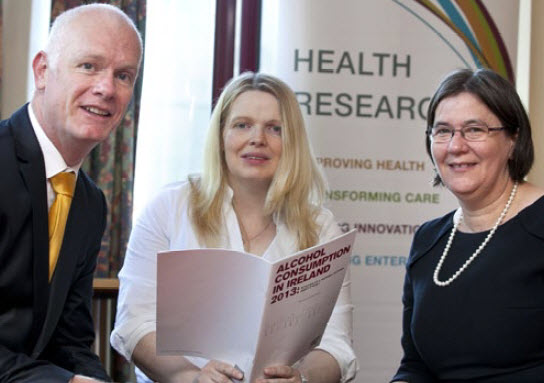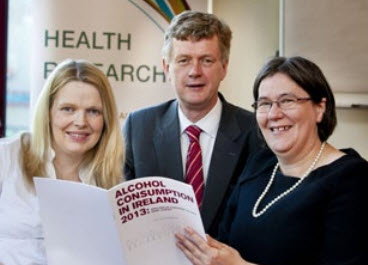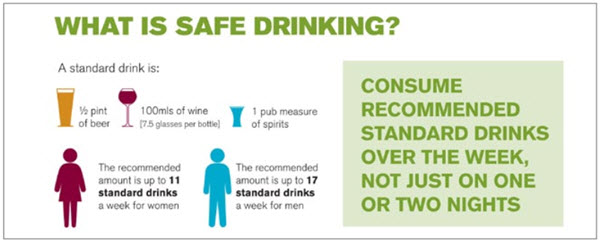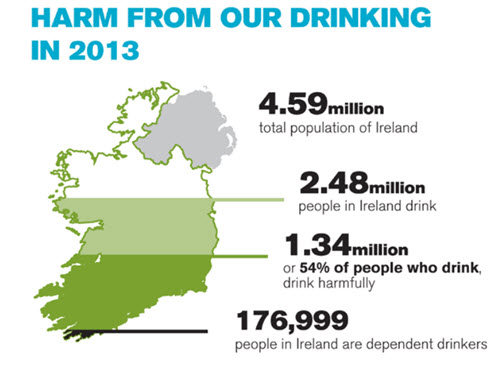Long, Jean and Mongan, Deirdre (2014) Alcohol in Ireland. Drugnet Ireland, Issue 51, Autumn 2014, pp. 1-4.
| Preview | Title | Contact |
|---|---|---|
|
PDF (Drugnet 51)
2MB |
The Irish have a complex relationship with alcohol. Its use is embedded in our national identity and it is often associated with significant cultural and religious events. It is generally accepted that the overall volume of alcohol consumption and the pattern of binge drinking predicts the incidence of alcohol-related harm. The HRB’s recently published 2013 National Alcohol Diary Survey supports these international findings.1
Definitions
A standard drink
The HSE defines a standard drink as 10 g of pure alcohol, i.e. half a pint of beer, 100 ml of wine (one bottle contains 750 ml) or a pub measure of spirits. Guidelines to low-risk drinking recommend maximum weekly consumption of 11 standard drinks for women and 17 standard drinks for men, which is roughly a maximum of one and a half bottles of wine spread over five nights of the week for a woman, and a maximum of eight and a half pints of beer spread over five nights of the week for a man.
Binge drinking (more correctly known as single occasion risky drinking)
Binge drinking has been calculated as six or more standard drinks, i.e. three or more pints of beer, six or more pub measures of spirits or 600ml or more of wine.
Harmful drinking
Harmful drinking is determined by the amount you drink on a typical occasion, how frequently you drink and how often you binge-drink. A typical example of a harmful drinker is someone who drinks 7–9 standard drinks (e.g. 4–5 pints or a bottle of wine) on a typical drinking occasion, who does this two to three times per week and who binge-drinks one or more times per week.


(1) Dr Graham Love, CEO Health Research Board, and authors Dr Deirdre Mongan and Dr Jean Long at the launch of the report of the National Alcohol Diary Survey (2) Dr Joe Barry (centre), TCD
The results of a 2012 survey, Alcohol: Public knowledge, attitudes and behaviour,2 showed that 85% of 1,020 respondents believed that the current level of alcohol consumption in Ireland is too high, and 73% believed that Irish society tolerates high levels of alcohol consumption. The 2013 National Alcohol Diary Survey confirms these perceptions. Among those who participated in the survey and who reported consuming alcohol, 75% consumed their alcohol during a binge-drinking session. In addition, 37% of participants who were drinkers engaged in binge drinking at least once per month, and almost two-fifths had consumed six or more standard drinks during a typical drinking session in the last year. More than half (54%) of 18–75-year-old drinkers who participated in the survey were classified as harmful drinkers, which equates to 1.35 million harmful drinkers in Ireland. Using the World Health Organization’s DSM-IV criteria for measuring dependence, which is the gold standard for identifying dependence in a clinical setting, 7% of participants were dependent on alcohol, which equates to an estimated 176,000 dependent drinkers in Ireland.
Why should we be concerned about these patterns of alcohol consumption in Ireland? Patterns of drinking, especially binge-drinking, play an important role in causing alcohol-related harm. It is the large number of low- to medium-volume drinkers in a population who binge-drink on occasion who account for many of our alcohol-related problems, such as injuries, violence, and poor work performance. In the National Alcohol Diary Survey, 30% of drinkers reported experiencing economic, health or social harms as a result of their alcohol use, with men 1.5 times more likely than women to report harms (men 35.7%, women 24.1%). Binge drinkers, when compared to other drinkers (who did not binge), were between two and three times more likely to experience harms from their own drinking.
The range and magnitude of the harm caused by alcohol in Ireland is considerable. Between 1995 and 2009 the number of people discharged from Irish hospitals with a diagnosis of alcoholic liver disease increased by 191%, with the largest increase observed among those aged 15–34 years.3 In 2012, alcohol was found to have been consumed in four out of ten episodes of self-harm in Ireland. Alcohol was associated with 2,000 beds occupied every night in Irish acute hospitals, at a time when the health service is seriously stretched.3 This does not include emergency departments, although anecdotal evidence indicates that people with alcohol-related conditions constitute a huge burden and enormous cost to emergency departments, particularly at night and at weekends. The cost to the health service is estimated at €1.2 billion, which would go a long way towards clearing waiting lists, paying for medical cards, and providing badly needed home-help and respite care.
Our perceptions of what we drink differ hugely from the reality. In the 2013 National Alcohol Diary Survey, respondents were asked to classify their own drinking behaviour. A small proportion of respondents (2.1%) classified themselves as heavy drinkers even though 7% met the criteria for dependence. In addition, one in five who self-defined as ‘light drinkers who do not binge drink’ and half of those who self-defined as ‘moderate drinkers who do not binge drink’ did engage in binge-drinking on a typical drinking occasion. These findings indicate that brief interventions are required during routine health visits and that clear and accurate information on low-risk drinking needs to be promoted.
The 2012 Alcohol: Public knowledge, attitudes and behaviour survey found that people have difficulty measuring their own drinking against the standard drink measure, although almost 6 out of 10 (58%) had heard of the term ‘standard drink’.2 Only one in ten respondents (9%) correctly identified the number of standard drinks in each of the four measures of alcohol asked about in the survey, and knew the recommended maximum number of standard drinks (proxy for low-risk drinking) that they could safely consume in one week. The Department of Health and the HSE currently provide information on low-risk drinking and standard drinks through the website https://www2.hse.ie/wellbeing/alcohol/improve-your-health/weekly-low-risk-alcohol-guidelines.html .
Research has shown that a combination of measures is needed to tackle alcohol consumption effectively. These include pricing, availability, advertising and sponsorship as well as information. The Public Health (Alcohol) Bill aims to reduce Irish consumption to the maximum low-risk level of 9.2 litres per capita per year.4 It will focus on a combination of measures to achieve this.


1 Long J and Mongan D (2014) Alcohol consumption in Ireland 2013: analysis of a national alcohol diary survey. Dublin: Health Research Board. www.drugsandalcohol.ie/22138
2 Ipsos MORI (2012) Alcohol: public knowledge, attitudes and behaviours. Dublin: Health Research Board. www.drugsandalcohol.ie/18022
3 Mongan D, McCormick PA, O'Hara S, Smyth BP and Long J (2011) Can Ireland's increased rates of alcoholic liver disease morbidity and mortality be explained by per capita alcohol consumption? Alcohol and Alcoholism 46 (4): 500. www.drugsandalcohol.ie/14978
4 Department of Health (2012) Steering group report on a national substance misuse strategy. Dublin: Department of Health. www.drugsandalcohol.ie/16908
A Substance use and dependence > Effects or consequences
B Substances > Alcohol
G Health and disease > Substance use disorder (addiction) > Alcohol use disorder > Alcohol dependence
J Health care, prevention, harm reduction and treatment > Harm reduction > Substance use harm reduction
VA Geographic area > Europe > Ireland
Repository Staff Only: item control page